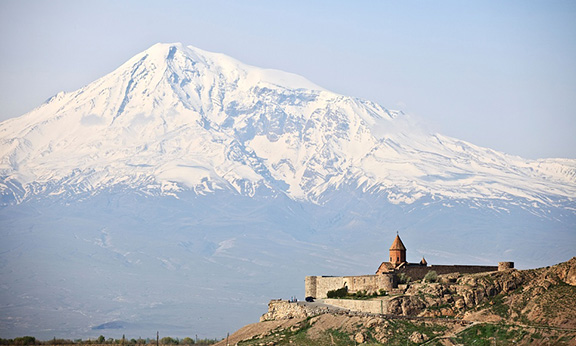Faith and philanthropy? Behind Armenia’s church-building boom

Khor Virap monastery is one of Armenia’s oldest spiritual sites. In recent years the super-rich have built many more (Source: Alamy)
GAYANE ABRAHAMYAN FOR EURASIANET, PART OF THE NEW EAST NETWORK
FROM THE GUARDIAN
Tycoons have donated millions of dollars to religious construction over the last 15 years, but questions surround the practice. Eurasianet.org reports
Some multi-millionaire philanthropists fund universities and hospitals, while others opt to fund charities. But in Armenia, the super-rich seem to prefer building churches.
So far, in 2015 alone, some of the country’s most powerful and wealthy public figures have provided significant funds for work on five construction projects across the country.
The Armenian tycoon Gagik Tsarukian, founder of one of the country’s largest political parties has this year paid for work on two churches.
Overall, Tsarukian has been involved in the building or reconstruction of seven churches since 2000, estimated to have cost him tens of millions of dollars.
He’s not alone. The prime minister Hovik Abrahamian, a millionaire businessman in his own right, contributed a church to his south-western constituency, Artashat, where his son Argam is town mayor. French-Armenian philanthropist Sarkis Petoian and Russia-based real-estate magnate Samvel Karapetian have also funded churches.
Since 1999, roughly 250 churches and monasteries have been built or restored, according to the office of Catholicos Karekin II, the spiritual leader of the Armenian Church.
What’s behind the boom?
Some observers say that it’s because Christianity plays a central role in Armenian society, since the nation became the first to adopt Christianity as their official religion in 301 AD.
Others have been more critical. Stepan Danielian, a rights advocate and chairperson of the non-profit Co-operation for Democracy has noted the church does not examine the sources of financing for those it consecrates.
The benefactors themselves are also reluctant to discuss the specifics of their donations.
“We have never publicised what kind of financial investment has been made in the sphere of church construction because it has been done purely out of devotion,” said Iveta Tonoian, director of the Gagik Tsarukian Charitable Foundation, the entity that oversees the tycoon’s church construction projects.
Similarly, real estate mogul Samvel Karapetian is unable to put an exact figure on his investment. “I can’t answer exactly; maybe several million [dollars],” he told journalists at his church’s groundbreaking ceremony in April.
Significant tax perks are available to those with the clout to invest in building churches. Armenia’s tax code allows charities to receive a tax exemption for any purchased supplies, financial transfers or work done in building a new church.
Benefactors also don’t pay taxes on the purchase of land where the church will be located and they can take an income tax deduction for charitable donations.
Future running costs are met by the Armenian Apostolic Church, who pay for clergy and maintaining the buildings.
Former prime minister Hrant Bagratian said in parliament this May that these expenses can run into tens of millions of dollars. The church disputes that figure.
Work or worship?
In a country where the official unemployment rate is 21%, the construction of churches has prompted questions about misplaced priorities.
In Nor Hachn, site of a Tsarukian-funded church, Marineh Karapetian, whose husband once worked at the town’s shuttered diamond factory, complained that “a plant should have been built, rather than a church.”
With a reopened diamond factory “some 500 people would have jobs,” she added. “Wouldn’t we pray more arduously in that case, and praise Tsarukian with more love and gratitude?”
But Bishop Bagrat Galstanian, director of the Office on Ecclesiastical Liturgical Issues at Etchmiadzin, seat of the Armenian Apostolic Church counters that construction of the tycoon-funded churches provides work for Armenian quarries, manual labourers, and artists.
Galstanian also maintains that demand for new churches is real.
“It does not really matter who has commissioned [a new church],” the bishop stressed, “because it is an eternal value and what matters most is how beneficial the new church can be to people, [and] what service it can provide to society.”
A version of this article first appeared on Eurasianet.org
